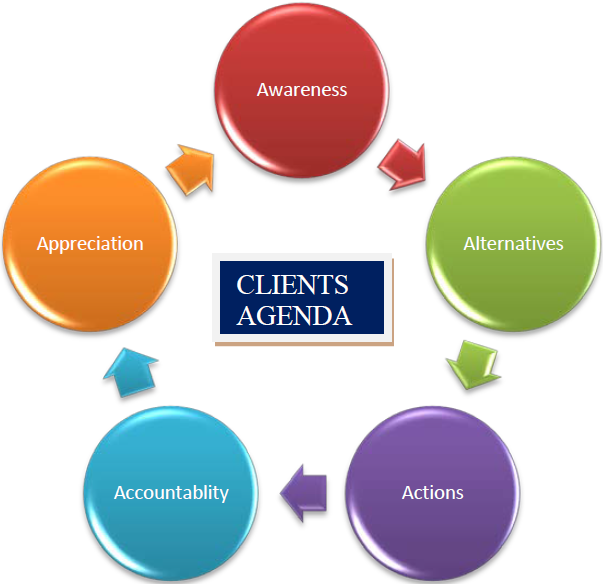A Coaching Model Created by Sanjay Nangalia
(Business & Executive Coach, UNITED STATES)
My coaching model is client centric. At the center and core of the A5 model is the client and their agenda. The role of the coach is to hold the space for the client and flow with their agenda. The A5 coaching model allows the coach to support the client to come to come to self awareness of the real issues that the client is dealing with; decide the what they want to do with the issue, explore the alternatives that will work best for them; narrow down on the alternatives ,work towards a SMART actions plan ,help them to decide an accountability structure and finally appreciate, acknowledge and celebrate their progress.
The objective is to help the client move forward in the direction they want at the pace they set for themselves. The client and the client’s agenda is the focus of A5.
It has the following phases:
| Awareness | Objective: To lead the client to self awareness .This phase involves listening to the client to understand their concerns. Often times, they have a vague understanding of their own concerns or are unable to articulate their real concerns. Using powerful questions in this phase allows for uncovering the heart of the issue and helps them to get clarity on what results/goal they want to achieve and the underlying issues. |
| Alternatives | Objective: Exploring the client issues:where the client is now and discover various options In this phase, the coach inquires of the client the current reality to help the client gain a clear understanding what surrounds the issues. This allows the client to explore options that would help to achieve the results/goal they want based on Phase I Awareness. The coach supports the client to think through the pro and cons of each option. |
| Action | Objective: Design the action steps. The client selects the best options which would work to achieve the results that they want. In the phase the client defines and agrees to actions to be done within specified time lines. The actions are aligned to the results expected by the client and are in the SMART format (Specific, Measurable, Achievable, Realistic and Time Bound). |
| Accountability | Objective: Design the accountability structure. The coach discusses accountability structures to support the actions are carried out . This is based on what will work best for the client .If the client decides to request the coach to hold the client accountable for these actions, and review them on a subsequent coaching sessions then the coach makes notes and has to follow up on the same. |

